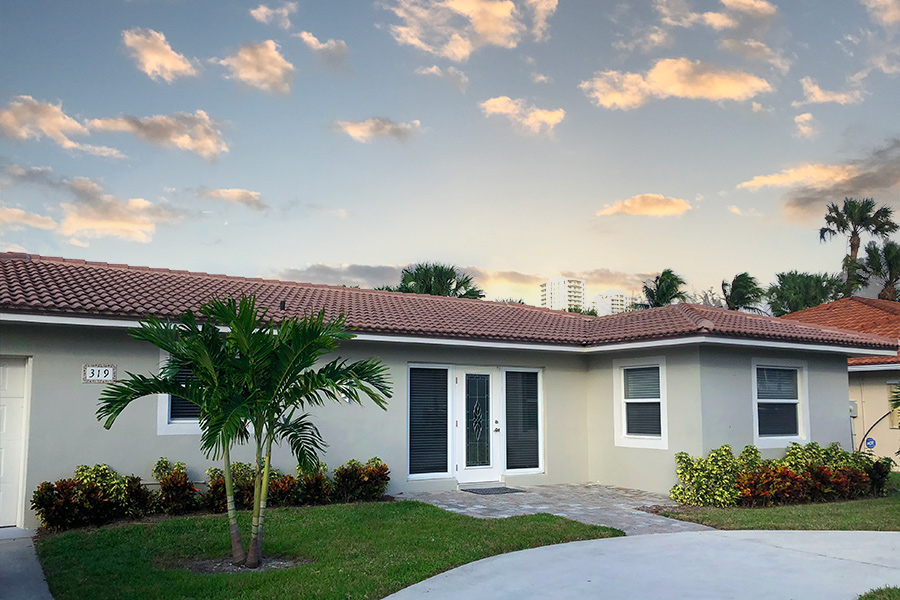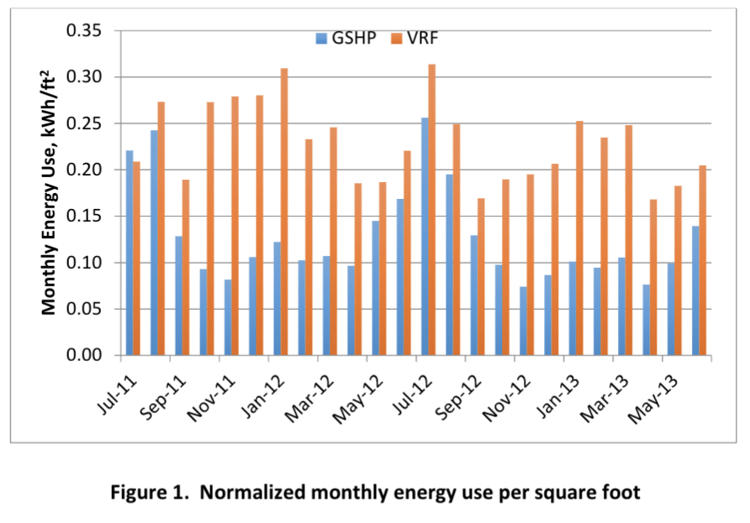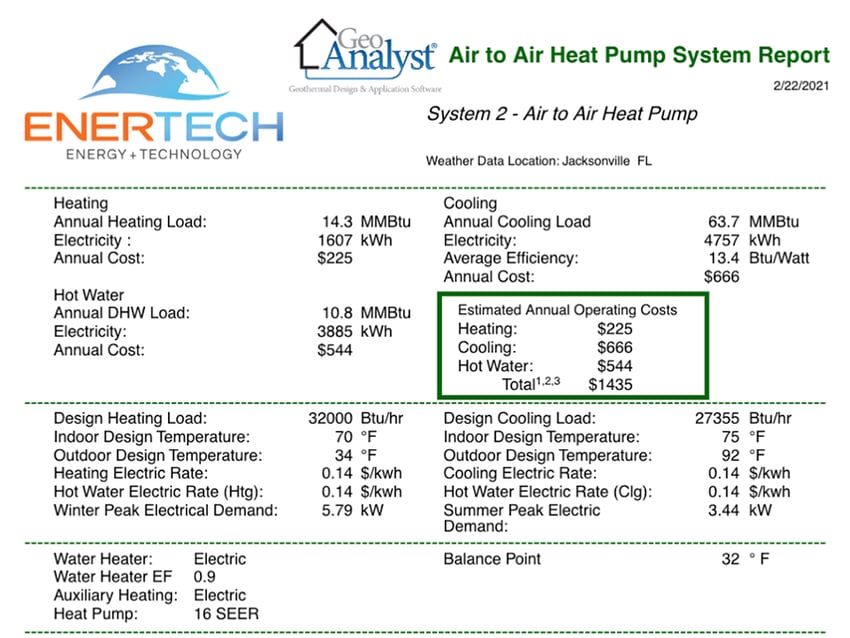Here at GeoComfort, one of the many services we provide to our customers is the analysis of different systems in comparison to a new GeoComfort geothermal heat pump system. We take into account the location and needs of the home, as well as what an appropriately-sized system from both technologies would cost in heating mode, cooling mode, and in supplying domestic hot water.
So far, we've covered how geothermal stacks up against natural gas and propane, two of the most popular heating methods in the country. Today, let's take a look at a heating and cooling system that is prevalent in "cooling-dominant" locations: an air-to-air heat pump. In this case study, we'll review the differences in the technologies, the performance in heating and cooling, and how the savings compare between geothermal and air-to-air heat pumps in a real-life scenario.

Will Geothermal Save You Money Over Traditional Heat Pumps?
How Do Geothermal and Air-to-Air Systems Work?
From a technical standpoint, geothermal heat pumps and air-to-air heat pumps are not too dissimilar! A bit of clarity is added when you call a geothermal heat pump what it actually is: a ground-source heat pump.
This distinction brings things into context. A geothermal system uses the earth to move heat energy, while an air--to-air heat pump uses, well, the air! This concept of heat-exchange is how any heating and cooling system works. Heat energy is the thing being moved from place to place. In winter, heat is drawn into the home from the heat source. In summer, heat is drawn away from the home and "dumped" into a heat sink.
Air-to-air heat pumps come in many varieties. You may hear them called "ductless" or "multi-zone" systems, which just refers to the different installations and formats that the technology can take. One thing remains the same: the unit is using the surrounding air to draw and deposit heat energy. Here are some different types and installations of air-to-air heat pumps that you may encounter:
- Ductless: A very low barrier-to-entry installation method, ductless applications require only a small hole to be drilled through the wall in order to connect the indoor and outdoor components. You'll often find these in home additions.
- Ducted: Best used in spaces where sufficient duct work is already present.
- Short-Run Ducted: If the space is only partially handled by ductwork, a short-run ducted system is optimal and often supplemented with other ductless units through the structure.
- Single-zone: With this method, there are indoor heads and outdoor condensers for every room.
- Multi-zone: Where two or more indoor heads are connected to a single outdoor condenser.
Air--to-air heat pumps are commonly recommended in cooling-dominant climates because they are an up-front "cheaper" alternative, they don't need to handle as much heating (at which geothermal also excels), and are generally more efficient than their traditional counterparts.
Air--to-air systems are not without their disadvantages, especially when pitted against a geothermal system. For starters, air-to-air units live outdoors, taking up valuable outdoor square footage, and contributing noise to the outdoor environment. In contrast, a geothermal unit lives indoors, typically in a closet or a basement. The cabinets are well insulated and typically produce about as much noise as a refrigerator!
How Do Geothermal and Air-to-Air Systems Differ?
The main difference between the systems is, as mentioned above, in the energy source. While both units use electricity to run the components, a bulk of the savings comes from how these units move energy to and from their respective sources. Air-to-air heat pumps extract heat from the surrounding air in winter and dump heat into the surrounding air in summer. Geothermal uses the earth to accomplish this. That all sounds fine, but when you really think about what these systems are up against, you can see how geothermal beats the competition. In heating mode, an air-to-air heat pump must extract heat energy from the surrounding air and use that energy to bring your home up to temperature. If it's below freezing, there is progressively less and less heat energy to extract, making the air-to-air heat pump work overtime to keep you comfortable.
With geothermal, the temperature of the soil that surrounds the buried loop field varies much less through the seasons, typically staying between 45°F - 70°F. In the dead of winter, geothermal can pull much more heat from the 50°F ground than it can pull from the 10°F air. In the summer, dumping heat energy into the comparatively cooler ground is, again, far easier than pushing that excess heat into the surrounding 90°F, 90% humidity air. There have been studies covering exactly this discrepancy in performance.
In a two-year study conducted by the American Society of Heating, Refrigerating, and Air-Conditioning Engineers (ASHRAE), the organization pitted a ground source heat pump system (geothermal) against a variable refrigerant flow system (air-to-air) on different floors of it's 31,000 sq. ft. headquarters. Over time, they found that the air-to-air (VRF) solution used "twice as much energy" as the geothermal system. In the below chart, in every month but the first month of study, the geothermal system tackled its heating and cooling work at far lower energy use per square foot in comparison to the installed VRF system.
If you'd like to get into the nitty gritty with the full report, you can read on here!
How Much Can You Save In Choosing Geothermal Over Air-to-Air?
Now, let's look at some actual data and compare the operation costs between the two systems. Since air-to-air solutions are commonly installed in warm or "cooling-dominant" climates, we've ran the data for this 2,500ft2 home in Jacksonville, Florida. Each system is set to keep the home at 70°F in heating mode (winter) and at 75°F in cooling mode (summer).
Savings On Hot Water Costs
Hot water costs are an often-overlooked place in which many homeowners can cut costs significantly. In a past article, we tackled some simple ways to reduce your hot water costs, but the HVAC system covers the most ground in that aspect by far. To meet the annual hot water load required by this home, the system needs to provide 10.8MMBtu of energy. For reference, MMBtu (Million British Thermal Units) is a unit measuring heat or, specifically, the amount of heat required to raise the temperature of one pound of water by one degree Fahrenheit. The greater the load, the greater the demand is on the system for heat delivery. To meet the home's need, it would cost $544 annually for an air-to-air system. If the home had geothermal installed, that number would be much lower, at $203 annually. Many GeoComfort units come with a factory-installed desuperheater, which is a component that uses excess energy to heat a portion (or all) of the home's hot water demand.
Savings On Heating Costs
The demand for heating in a climate like Jacksonville, Florida is minimal, but still vital. An electric heat pump system needs to be able to handle both heating and cooling at high efficiency. In this example, the annual heating load is sitting at 14.3MMBtu, which is comparatively low. For example, the heating load in this Illinois homeowner's case study was upwards of 61MMBtu. Even at this reduced load, the geothermal system comes in at 52% cheaper to operate than a high-efficiency air-to-air unit. The geothermal heat pump's annual operation cost in heating mode comes out to $107, while that same job would cost $225 for an air-to-air heat pump to handle.
Savings On Cooling Costs
When it comes to the cooling load, each system is up against a much larger task in the summer. High humidities can slow the transfer of energy, making it difficult for an inferior system to extract heat from the home and dump it into its respective heat sink. In the warm spring, summer, and early fall months in this study's climate, the annual cooling load is a respectable 63.7MMBtu, almost 4.5x greater than the annual heating load.
As we mentioned above, air-to-air heat pumps are at their best in warm temperatures, so it handles the annual load at an estimated $666 in operation cost. The geothermal system? It's coming in just under the competition here at $527 annually, or an average of $44 per month.
When everything is added up, geothermal costs 42% less on an annual basis to provide heating, cooling, and hot water to this Florida home.
Check out all the raw data below!
Other Considerations
In coastal areas in which the surrounding air boasts both high humidity and high saltiness (salinity), air-to-air systems can corrode at alarming rates. This isn't just relevant for beachfront properties, though. While the saltiness of the air gets exponentially greater as you get closer to the shoreline, significant levels of "atmospheric salinity" can be detected upwards of a mile inland.
Air-to-air heat pumps need to be swapped out frequently due to these high levels of corrosion and homeowners in these conditions regularly replace their systems in 5-7 years. Since geothermal doesn't necessitate the use of an open-air heat exchanger and the main unit lives indoors, it's much more protected from the elements and has a lifespan that's 92% longer than traditional systems.
Interested in learning more about how much you can save by making the switch to a geothermal system? Contact us today and get a free geothermal design!





